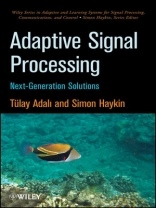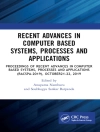Leading experts present the latest research results in adaptive signal processing
Recent developments in signal processing have made it clear that significant performance gains can be achieved beyond those achievable using standard adaptive filtering approaches. Adaptive Signal Processing presents the next generation of algorithms that will produce these desired results, with an emphasis on important applications and theoretical advancements. This highly unique resource brings together leading authorities in the field writing on the key topics of significance, each at the cutting edge of its own area of specialty. It begins by addressing the problem of optimization in the complex domain, fully developing a framework that enables taking full advantage of the power of complex-valued processing. Then, the challenges of multichannel processing of complex-valued signals are explored. This comprehensive volume goes on to cover Turbo processing, tracking in the subspace domain, nonlinear sequential state estimation, and speech-bandwidth extension.
* Examines the seven most important topics in adaptive filtering that will define the next-generation adaptive filtering solutions
* Introduces the powerful adaptive signal processing methods developed within the last ten years to account for the characteristics of real-life data: non-Gaussianity, non-circularity, non-stationarity, and non-linearity
* Features self-contained chapters, numerous examples to clarify concepts, and end-of-chapter problems to reinforce understanding of the material
* Contains contributions from acknowledged leaders in the field
Adaptive Signal Processing is an invaluable tool for graduate students, researchers, and practitioners working in the areas of signal processing, communications, controls, radar, sonar, and biomedical engineering.
İçerik tablosu
Preface.
Contributors.
Chapter 1 Complex-Valued Adaptive Signal Processing.
1.1 Introduction.
1.2 Preliminaries.
1.3 Optimization in the Complex Domain.
1.4 Widely Linear Adaptive Filtering.
1.5 Nonlinear Adaptive Filtering with Multilayer Perceptrons.
1.6 Complex Independent Component Analysis.
1.7 Summary.
1.8 Acknowledgment.
1.9 Problems.
References.
Chapter 2 Robust Estimation Techniques for Complex-Valued Random Vectors.
2.1 Introduction.
2.2 Statistical Characterization of Complex Random Vectors.
2.3 Complex Elliptically Symmetric (CES) Distributions.
2.4 Tools to Compare Estimators.
2.5 Scatter and Pseudo-Scatter Matrices.
2.6 Array Processing Examples.
2.7 MVDR Beamformers Based on M -Estimators.
2.8 Robust ICA.
2.9 Conclusion.
2.10 Problems.
References.
Chapter 3 Turbo Equalization.
3.1 Introduction.
3.2 Context.
3.3 Communication Chain.
3.4 Turbo Decoder: Overview.
3.5 Forward-Backward Algorithm.
3.6 Simplified Algorithm: Interference Canceler.
3.7 Capacity Analysis.
3.8 Blind Turbo Equalization.
3.9 Convergence.
3.10 Multichannel and Multiuser Settings.
3.11 Concluding Remarks.
3.12 Problems.
References.
Chapter 4 Subspace Tracking for Signal Processing.
4.1 Introduction.
4.2 Linear Algebra Review.
4.3 Observation Model and Problem Statement.
4.4 Preliminary Example: Oja’s Neuron.
4.5 Subspace Tracking.
4.6 Eigenvectors Tracking.
4.7 Convergence and Performance Analysis Issues.
4.8 Illustrative Examples.
4.9 Concluding Remarks.
4.10 Problems.
References.
Chapter 5 Particle Filtering.
5.1 Introduction.
5.2 Motivation for Use of Particle Filtering.
5.3 The Basic Idea.
5.4 The Choice of Proposal Distribution and Resampling.
5.5 Some Particle Filtering Methods.
5.6 Handling Constant Parameters.
5.7 Rao-Blackwellization.
5.8 Prediction.
5.9 Smoothing.
5.10 Convergence Issues.
5.11 Computational Issues and Hardware Implementation.
5.12 Acknowledgments.
5.13 Exercises.
References.
Chapter 6 Nonlinear Sequential State Estimation for Solving Pattern-Classification Problems.
6.1 Introduction.
6.2 Back-Propagation and Support Vector Machine-Learning Algorithms: Review.
6.3 Supervised Training Framework of MLPs Using Nonlinear Sequential State Estimation.
6.4 The Extended Kalman Filter.
6.5 Experimental Comparison of the Extended Kalman Filtering Algorithm with the Back-Propagation and Support Vector Machine Learning Algorithms.
6.6 Concluding Remarks.
6.7 Problems.
References.
Chapter 7 Bandwidth Extension of Telephony Speech.
7.1 Introduction.
7.2 Organization of the Chapter.
7.3 Nonmodel-Based Algorithms for Bandwidth Extension.
7.4 Basics.
7.5 Model-Based Algorithms for Bandwidth Extension.
7.6 Evaluation of Bandwidth Extension Algorithms.
7.7 Conclusion.
7.8 Problems.
References.
Index.
Yazar hakkında
TÜLAY ADALI, Ph D, is Professor of Electrical
Engineering and Director of the Machine Learning for Signal
Processing Laboratory at the University of Maryland, Baltimore
County. Her research interests are in statistical and adaptive
signal processing, with emphasis on nonlinear and complex-valued
signal processing, and applications in biomedical data analysis and
communications.
Simon Haykin, Ph D, is Distinguished University Professor
and Director of the Cognitive Systems Laboratory in the Faculty of
Engineering at Mc Master University. A world-renowned authority on
adaptive and learning systems, Dr. Haykin has pioneered
signal-processing techniques and systems for radar and
communication applications, culminating in the study of cognitive
dynamic systems, which has become his research passion.












